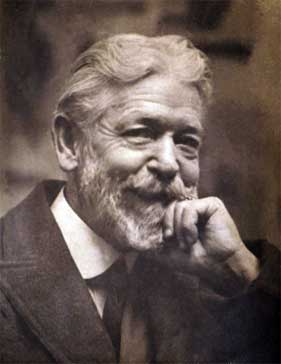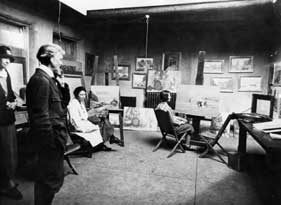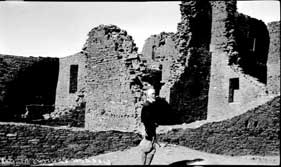Warren Eliphalet Rollins (1861-1962)
Warren Rollins was born in Carson City, Nevada, and spent his boyhood years in Oakland, California. He attended the San Francisco School of Design (now San Francisco Institute of Art), where he studied with Virgil Williams and received the Avery Gold Medal for excellence in painting. After a brief tenure as the associate director of the School, Rollins had a studio at the Alameda, CA, lighthouse where he established his early reputation as a painter of ships seascapes.
Rollins spent the next 15 years in Portland, OR, where, in addition to his painting, he conducted an art school and began illustrative work for magazines in the West. Near the end of this period, he received commissions for two large canvasses to be displayed at the Lewis and Clark Exposition of 1905. He spent several years researching these paintings, traveling to Montana, Wyoming, and as far east as the Dakotas, studying the scenery and Native Americans of the northern Great Plains. While researching these paintings, Rollins lived and taught in Billings, MT, where painted a portrait of Calamity Jane which was later destroyed by fire.
His interest in the life and customs of Native Americans influenced his subsequent move to the Southwest, where he lived for months at a time among the Navajo, Zuni, and Pueblo. By 1909, the peripatetic artist was working in New Mexico where he soon persuaded the territorial governor to allow him to mount the first art exhibition in Santa Fe. There, Rollins became president of the Santa Fe Artists Club and was affectionately known as the “dean of the Santa Fe art colony.” Between 1910 and 1916, Rollins divided his time between studios in Santa Fe, Phoenix and San Gabriel, CA, later settling in Chaco Canyon, NM in the late 1920s.
By the mid 1930s, Rollins developed a palsy that made painting difficult and began experimenting with wax crayons. He developed a technique of layering colors to increase the depth and intensity of color, mounting his first crayon exhibit at the Art Museum of New Mexico in 1938. He continued his experimentation with Crayola crayons while living in Baltimore, MD, in the 1940s where he completed a series of drawings inspired by World War II and, returning to the marine themes that had so interested him as a young man, a series of the Pilgrim ship, Mayflower. Rollins returned to the Southwest in 1952 where he maintained a full schedule of drawing and teaching. He died at the age of 100 in Winslow, AZ.

Warren E. Rollin

